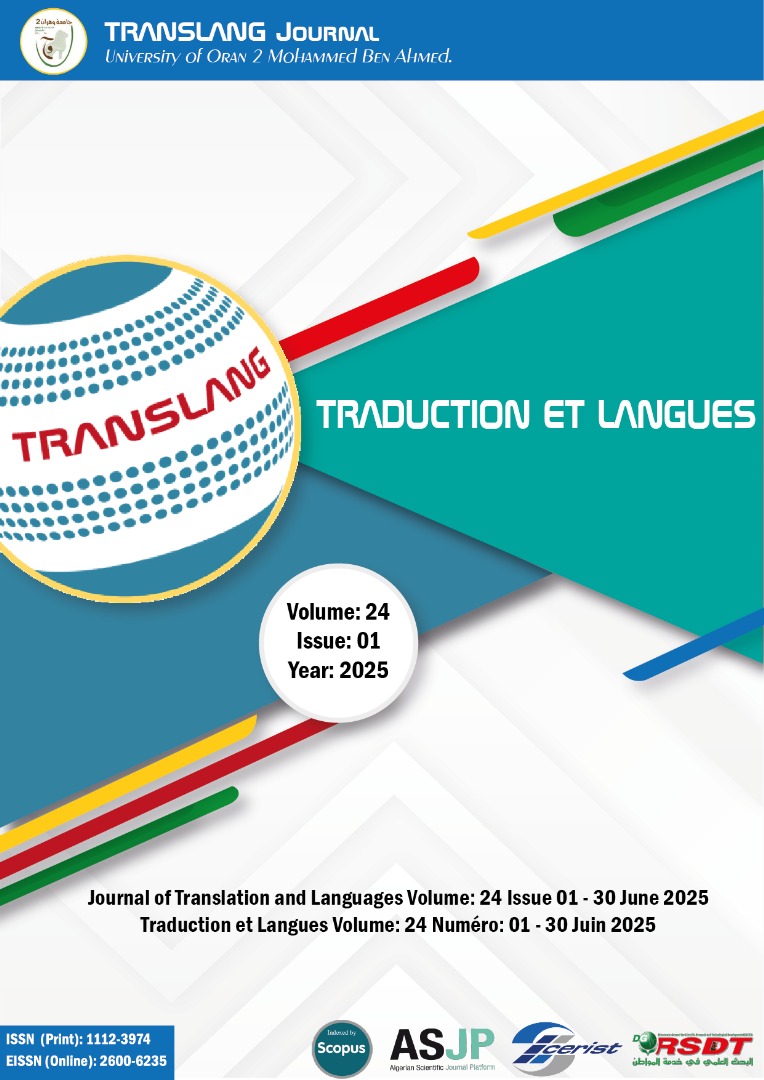Mirroring Meaning: Reduplication in Vietnamese Literary Prose and Its English Translation- A Contrastive Perspective Phản chiếu ý nghĩa: Hiện tượng láy trong văn xuôi văn học Việt Nam và bản dịch tiếng Anh- Góc nhìn đối chiếu
Main Article Content
Abstract
In Vietnam, the increasing use of translated texts reflects the growing effort to introduce Vietnamese literature to a global audience. This study examines the use of both partial and full reduplication in the Vietnamese version of Cánh đồng bất tận and its English translation, exploring how each type is employed in both languages and analyzing the similarities and differences in their usage. Based on the novella Cánh đồng bất tận and its English translation, the research examined 96 Vietnamese sentences and 105 English sentences to explore the phenomenon. The sentences were purposively selected from the novella to focus on examples of reduplication, and the contrastive analysis was conducted using a linguistic framework that compares morphological and phonological features across the two languages. The findings revealed that (1) Both English and Vietnamese employed similar methods for using reduplication in the novella, utilizing repetition of sounds or words to create emphasis, express intensity, and add a rhythmic or playful quality to the language, (2) Although reduplication is not a fundamental morphological process in English, it occurs more frequently than in Vietnamese in this text, primarily as a stylistic or emphatic device rather than a grammatical one, and (3) The rules governing letter- and word-groupings, such as the use of reduplication in both Vietnamese and English, contribute to making the text more engaging for readers by adding rhythm, emphasis, and expressiveness. Additionally, the findings also revealed that pairs of tonal patterns combined with descriptive words using the suffix -ish, create a unique and interesting linguistic feature in English. This study uncovers how reduplication functions differently in Vietnamese and English within a bilingual novella, revealing nuanced strategies translators can use to preserve stylistic emphasis and cultural meaning, thereby improving the fidelity and expressive quality of translations for diverse audiences.
Metrics
Article Details
References
Anis, M. Y., Malik, A., & Setiyadi, A. C. (2022). Developing creative writing process based on the translation of Arabic phrases: Case study in arabic prose and poetry. Journal of Narrative and Language Studies, 10(20), 173-187. https://doi.org/10.59045/nalans.2023.3
Chanh, N. H (2021a). Simile As An Effective Literary Device in the Vietnamese-English Translation Equivalent. REiLA : Journal of Research and Innovation in Language, 3(2), 115-123. https://doi.org/10.31849/reila.v3i2.6829
Chanh, N. H. (2021b). Aiding the translation process with affixal analysis – A case study in “The Old Man and The Sea”. Ho Chi Minh City University of Education Journal of Science, 18(4), 592-603.
[5] Inkelas, S., & Downing, L. J. (2015). What is Reduplication? Typology and Analysis Part 1/2: The Typology of Reduplication. Language and Linguistics Compass, 9, 502-515. https://doi.org/10.1111/lnc3.12166
Downing, L. J., & Inkelas, S. (2015). What is reduplication? Typology and analysis part 2/2: The analysis of reduplication. Language and Linguistics Compass, 9(12), 516-528. https://doi.org/10.1111/lnc3.12152
Inkelas, S. (2008). The dual theory of reduplication. Linguistics, 46(2), 351–401. https://doi.org/10.1515/LING.2008.013
Jin, J., & Fang, Z. (2019). A comparative study on reduplication in English and Chinese. Advances in social science, education and humanities research, 319(5), 420-424. https://doi.org/10.2991/ichssr-19.2019.80
Kołłątaj, A. (2010). Reduplication in English Rhyming Slang. Acta Neophilologica, 12(1), 93-103.
Moravcsik, E. (1992). Reduplication, International Encyclopedia of Linguistics. Oxford University Press.
Kajitani, M. (2005). Semantic properties of reduplication among the world’s languages. In Rebecca Shields (ed.), LSO working papers in linguistics volume 5: Proceedings of WIGL 2005, 93–106.
Liem, N. D. (1974). Modern Linguistic Theories and Contrastive Analysis of English and Vietnamese. South-East Asian linguistic studies, 1, 111-117.
Nguyen, D. L. (1966). A contrastive analysis of English and Vietnamese (Vol 1): English grammar: A combined tagmemic and transformational approach. Australian National University Press.
Nguyen, D. L. (1967). A contrastive analysis of English and Vietnamese (Vol 2): A contrastive grammatical analysis of English and Vietnamese. Australian National University Press.
Nguyen, D. L. (1969). A contrastive analysis of English and Vietnamese (Vol 3): Vietnamese grammar. Australian National University Press.
Nguyen, D. L. (1970). A contrastive analysis of English and Vietnamese (Vol 4): A contrastive phonological analysis of English and Vietnamese. Australian National University Press.
Okamura, T. (1991). Reduplication in English. English Review, 5, 1-24.
Odiegwu, N. C., & Faraclas, N. (2025). Reduplication in Nigerian English. World Englishes, 1–15. https://doi.org/10.1111/weng.12725
Pi, T. (1995). The structure of English iteratives. Canadian Linguistics Association.
Pots, C., & Dirix, P. (2023). On contrastive reduplication. Adding Dutch to the West Germanic typology. Leuvensche bijdragen, 104(2022-23), 38-61.
Richards, J., & Schmidt, R. (2010). Longman dictionary of language teaching and applied linguistics. Pearson Education Publishing House.
Shi, X. (2014). The English Film Title Translation Strategies. Journal of Language Teaching & Research, 5(3), 606-610.
Su, J. (2024). L2 acquisition of classifier reduplication in Chinese. Lingua, 305, 1-24. https://doi.org/10.1016/j.lingua.2024.103736
Travis, L. D. (2001). The syntax of reduplication. North East Linguistics Society.
Terfa, A. (2020). Reduplications in the Tiv grammar: Classifications and functions. Journal of linguistics and foreign languages, 1(2), 57-75.
Lieber, R. (2021). The Oxford Encyclopedia of Morphology. Oxford University Press.
Urbanczyk, S. (2011). Reduplication. Oxford Bibliographies in Linguistics.
Xu, D. (2012). Reduplication in languages: A case study of languages of China. In Dan Xu (ed.), Plurality and classifiers across languages in China (pp. 43–64). Mouton de Gruyter.
